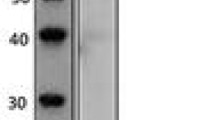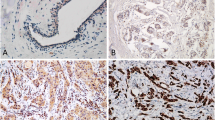Abstract
Purpose
Peroxisome proliferator-activated receptor γ (PPARγ) is a nuclear receptor expressed in a large number of human cancers and plays important roles in breast cancer cell proliferation. Its association with clinicopathologic features and Wnt/β-Catenin signaling pathway, a crucial factor in embryonic and malignant development, in breast cancer has not been reported systematically. In the present study, expression patterns, interaction and the correlations with clinical/prognostic factors of PPARγ and β-Catenin were investigated among patients with breast cancer.
Methods
Using immunohistochemistry, we performed a study on 70 patient-derived human breast tumors and compared the protein expression levels of PPARγ, β-Catenin and Ki-67. Correlations were then analyzed between IHC-assessed level of these molecules and major clinicopathologic variables and survival. Furthermore, western blot (WB) analysis before and after immunoprecipitation with PPARγ and β-Catenin were performed on breast cancer tissues and cell lines to evaluate their protein level and molecular interaction.
Results
We showed that PPARγ expression was of significant prognostic value in the outcome of breast carcinomas, which positively correlated with ER status (P = 0.012) and inversely associated with histologic grade (P = 0.012), tumor size (P = 0.007), axillary lymph node status (P = 0.044), TNM stage (P = 0.026), Ki-67 (P = 0.006) and abnormal β-Catenin expression (P = 0.023), whereas no correlation was seen between PPARγ and age (P = 0.513), histology (P = 0.764), PR (P = 0.099) or HER-2 status (P = 0.175). Kaplan–Meier survival curves of the study population showed that high expression level of PPARγ significantly correlated with long-term survival. Molecular interaction could also be demonstrated between PPARγ and β-Catenin both in breast cancer cell lines and tissue samples.
Conclusions
On the basis of these results, we suggested that PPARγ might serve as a future target for the development of novel treatments in breast cancer.




Similar content being viewed by others
Abbreviations
- PPARγ:
-
Peroxisome proliferator-activated receptor γ
References
Alghanem AA, Hussain S (1986) The effect of tumor size and axillary lymph node metastasis on estrogen and progesterone receptors in primary breast cancer. J Surg Oncol 31:218–221. doi:10.1002/jso.2930310317
Altiok S, Xu M, Spiegelman BM (1997) PPARgamma induces cell cycle withdrawal: inhibition of E2F/DP DNA-binding activity via downregulation of PP2A. Genes Dev 11:1987–1998. doi:10.1101/gad.11.15.1987
Cho E, Spiegelman D, Hunter DJ, Chen WY, Stampfer MJ, Colditz GA, Willett WC J (2003) Premenopausal fat intake and risk of breast cancer. Nat Cancer Inst 95:1079–1085
Clark GM, McGuire WL (1983) Prognostic factors in primary breast cancer. Breast Cancer Res Treat 3:S69–S72. doi:10.1007/BF01855130
Clements WM, Wang J, Sarnaik A, Kim OJ, MacDonald J, Fenoglio-Preiser C, Groden J, Lowy AM (2002) β-Catenin mutation is a frequent cause of Wnt pathway activation in gastric cancer. Cancer Res 62:3503–3506
Esteva FJ, Sahin AA, Cristofanilli M, Arun B, Hortobagyi GN (2002) Molecular prognostic factors for breast cancer metastasis and survival. Semin Radiat Oncol 12:319–328. doi:10.1053/srao.2002.35251
Gerdes J, Lemke H, Baisch H, Wacker HH, Schwab U, Stein H (1984) Cell cycle analysis of a cell proliferation-associated human nuclear antigen defined by monoclonal antibody Ki-67. J Immunol 133:1710–1715
Girnun GD, Smith WM, Drori S, Sarraf P, Mueller E, Eng C, Nambiar P, Rosenberg DW, Bronson RT, Edelmann W, Kucherlapati R, Gonzalez FJ, Spiegelman BM (2002) APC-dependent suppression of colon carcinogenesis by PPARgamma. Proc Natl Acad Sci USA 99:13771–13776. doi:10.1073/pnas.162480299
Gupta RA, Brockman JA, Sarraf P, Willson TM, DuBois RN (2001) Target genes of peroxisome proliferator-activated receptorγin colorectal cancer cells. J Biol Chem 276:29681–29687. doi:10.1074/jbc.M103779200
Hartmann WHUL, Sobin LH, Stalsberg H (1981) Histological typing of breast tumours. In: World Health Organization (ed) International classification of tumours, 2nd edn. Geneva, pp 15–25
He TC, Sparks AB, Rago C, Hermeking H, Zawel L, da Costa LT, Morin PJ, Vogelstein B, Kinzler KW (1998) Identification of c-MYC as a target of the APC pathway. Science 281:1509–1512. doi:10.1126/science.281.5382.1509
Hortobagyi GN (1998) Treatment of breast cancer. N Engl J Med 339:974–984. doi:10.1056/NEJM199810013391407
Ikezoe T, Miller CW, Kawano S, Heaney A, Williamson EA, Hisatake J, Green E, Hofmann W, Taguchi H, Koeffler HP (2001) Mutational analysis of the peroxisome proliferator-activated receptorγgene in human malignancies. Cancer Res 61:5307–5310
Jho EH, Zhang T, Domon C, Joo CK, Freund JN, Costantini F (2002) Wnt/beta-Catenin/Tcf signaling induces the transcription of Axin2, a negative regulator of the signaling pathway. Mol Cell Biol 22:1172–1183. doi:10.1128/MCB.22.4.1172-1183.2002
Karatzas GKA, Syrigos KN, Chatzigianni E, Papanikolaou S, Simatos G, Papanikolaou D, Bogris S (2000) Expression patterns of the E-cadherin-Catenin cell–cell adhesion complex in gastric cancer. Hepatogastroenterology 47:1465–1469
Karayiannakis AJ, Nakopoulou L, Gakiopoulou H, Keramopoulos A, Davaris PS, Pignatelli M (2001) Expression patterns of β-Catenin in in situ and invasive breast cancer. Eur J Surg Oncol 27:31–36. doi:10.1053/ejso.1999.1017
Kim PJ, Plescia J, Clevers H, Fearon ER, Altieri DC (2003) Survivin and molecular pathogenesis of colorectal cancer. Lancet 362:205–209. doi:10.1016/S0140-6736(03)13910-4
Kitamoto M, Nakanishi T, Kira S, Kawaguchi M, Nakashio R, Suemori S, Kajiyama G, Asahara T, Dohi K (1993) The assessment of proliferating cell nuclear antigen immunohistochemical staining in small hepatocellular carcinoma and its relationship to histologic characteristics and prognosis. Cancer 72:1859–1865. doi:10.1002/1097-0142(19930915)72:6<1859::AID-CNCR2820720612>3.0.CO;2-A
Koutnikova H, Auwerx J (2002) PPARgamma, an X-ceptor for Xs. Ann N Y Acad Sci 967:28–33
Lehmann JM, Moore LB, Smith-Oliver TA, Wilkison WO, Willson TM, Kliewer SA (1995) An antidiabetic thiazolidinedione is a high affinity ligand for peroxisome proliferator-activated receptor gamma (PPAR gamma). J Biol Chem 270:12953–12956. doi:10.1074/jbc.270.50.30221
Lin SY, Xia W, Wang JC, Kwong KY, Spohn B, Wen Y, Pestell RG, Hung MC (2000) β-Catenin, a novel prognostic marker for breast cancer: its roles in cyclin D1 expression and cancer progression. Proc Natl Acad Sci USA 97:4262–4266. doi:10.1073/pnas.060025397
Liu J, Wang H, Zuo Y, Farmer SR (2006) Functional interaction between peroxisome proliferator-activated receptor γ and β-Catenin. Mol Cell Biol 26:5827–5837. doi:10.1128/MCB.00441-06
Lu D, Cottam HB, Corr M, Carson DA (2005) Repression of beta-Catenin function in malignant cells by nonsteroidal antiinflammatory drugs. Proc Natl Acad Sci USA 102:18567–18571. doi:10.1073/pnas.0509316102
Lustig B, Jerchow B, Sachs M, Weiler S, Pietsch T, Karsten U, van de Wetering M, Clevers H, Schlag PM, Birchmeier W, Behrens J (2002) Negative feedback loop of Wnt signaling through upregulation of conductin/axin2 in colorectal and liver tumors. Mol Cell Biol 22:1184–1193. doi:10.1128/MCB.22.4.1184-1193.2002
Morrison RF, Farmer SR (1999) Role of PPARgamma in regulating a cascade expression of cyclin-dependent kinase inhibitors, p18(INK4c) and p21(Waf1/Cip1), during adipogenesis. J Biol Chem 274:17088–17097. doi:10.1074/jbc.274.24.17088
Mueller E, Sarraf P, Tontonoz P, Evans RM, Martin KJ, Zhang M, Fletcher C, Singer S, Spiegelman BM (1998) Terminal differentiation of human breast cancer through PPAR gamma. Mol Cell 1:465–470. doi:10.1016/S1097-2765(00)80047-7
Papadaki I, Mylona E, Giannopoulou I, Markaki S, Keramopoulos A, Nakopoulou L (2005) PPARgamma expression in breast cancer: clinical value and correlation with ERbeta. Histopathology 46:37–42. doi:10.1111/j.1365-2559.2005.02056.x
Parkin DM, Bray F, Ferlay J, Pisani P (2005) Global cancer statistics. CA Cancer J Clin 55:74–108. doi:10.3322/canjclin.55.2.74
Peifer M, Polakis P (2000) Wnt signaling in oncogenesis and embryogenesis—a look outside the nucleus. Science 287:1606–1609. doi:10.1126/science.287.5458.1606
Qin C, Morrow D, Stewart J, Spencer K, Porter W, Smith R 3rd, Phillips T, Abdelrahim M, Samudio I, Safe S (2004) A new class of peroxisome proliferator-activated receptor gamma (PPARgamma) agonists that inhibit growth of breast cancer cells: 1, 1-Bis(3’-indolyl)-1-(p-substituted phenyl)methanes. Mol Cancer Ther 3:247–260
Remmele W, Muhlfait V, Keul HG (1995) Estimation of the proliferative activity of human breast cancer tissue by means of the Ki-67 and MIB-1 antibodies-comparative studies on frozen and paraffin sections. Virchows Arch 426:435–439. doi:10.1007/BF00193164
Rosen ED, Spiegelman BM (2001) PPARγ: a nuclear regulator of metabolism, differentiation, and cell growth. J Biol Chem 276:37731–37734. doi:10.1074/jbc.M106424200
Shtutman M, Zhurinsky J, Simcha I, Albanese C, D’Amico M, Pestell R, Ben-Ze’ev A (1999) The cyclin D1 gene is a target of the beta-Catenin/LEF-1 pathway. Proc Natl Acad Sci USA 96:5522–5527. doi:10.1073/pnas.96.10.5522
Tetsu O, McCormick F (1999) Beta-Catenin regulates expression of cyclin D1 in colon carcinoma cells. Nature 398:422–426. doi:10.1038/18884
Acknowledgments
This work was supported by Specialized Research Fund for the Doctoral Program of Higher Education (for new teachers, No. 20070246131), Natural Scientific Foundation of Jiangsu Province Grant (No. BK2006546 and No. BK2006547), Jiangsu “six personnel peak” talent-funded projects (No. 2006113), Doctoral start-up research fund of Nantong University(No. 03080174), the National Natural Scientific Foundation of China Grant (No. 30872320 and No. 30770488), and College and University Natural Scientific Research Program of Jiangsu Province (No. 03KJB180109, No. 04KJB320114 and No. 07KJD310172), Technology Guidance Plan for Social Development of Jiangsu Province Grant (BS2004526).
Author information
Authors and Affiliations
Corresponding authors
Additional information
Y. Jiang and L. Zou contributed equally to this work.
Rights and permissions
About this article
Cite this article
Jiang, Y., Zou, L., Zhang, C. et al. PPARγ and Wnt/β-Catenin pathway in human breast cancer: expression pattern, molecular interaction and clinical/prognostic correlations. J Cancer Res Clin Oncol 135, 1551–1559 (2009). https://doi.org/10.1007/s00432-009-0602-8
Received:
Accepted:
Published:
Issue Date:
DOI: https://doi.org/10.1007/s00432-009-0602-8




